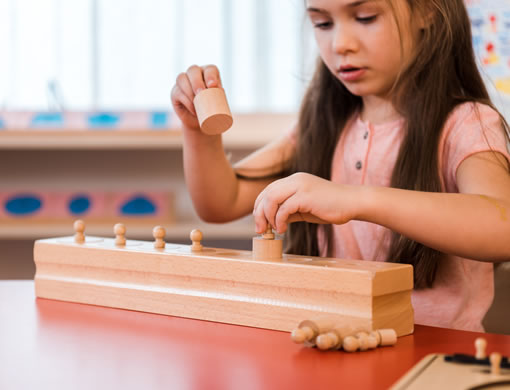- Contact Us: (713) 425-9548
- Email: Info@GreaterHoustonMontessori.org

Optimal Learning for Young Children

Choosing the right environment for a child’s education is one of the most important decisions a parent can make, and the Montessori approach stands out as the gold standard for cultivating lifelong learners and well-rounded individuals. Through its commitment to experiential learning, children are immersed in rich, real-world experiences that bring concepts to life and nurture curiosity at every turn. Tactile and interactive materials make abstract ideas accessible to young minds, fostering deep comprehension and genuine enthusiasm for learning. By supporting each individual’s natural pace and honoring the process of mastery, children grow in confidence and develop a resilient, self-motivated approach to academic and personal challenges. Critical thinking and collaborative problem-solving equips students with skills essential for success, both inside and outside the classroom. Moreover, the sense of community, teamwork, and open communication cultivated in a Montessori educational setting ensures every child learns how to work with others, share ideas, and respect different perspectives—traits that will benefit them for a lifetime.
-
Experiential Learning
-
Hands-On Materials
-
Individualized Pacing and Mastery
-
Development of Critical Thinking and Problem Solving
-
Integration of Collaboration and Communication
Experiential Learning
In the Montessori classroom, learning by doing is a core principle. Students are encouraged to engage directly with real-world problems and hands-on tasks. This means that instead of only reading about a scientific process or mathematical principle, learners participate in experiments, build models, conduct investigations, and actively interact with their environment. Such direct involvement deepens understanding and aids in long-term retention, since the learner forms connections through experience rather than passive observation.
Experiential learning also fosters independence and creative decision-making. Learners are often given choices in what activities to pursue or what questions to investigate, building self-confidence as they take ownership of their educational journey. Activities like preparing for a cultural celebration or conducting a group science project not only teach academic concepts but also facilitate teamwork, global awareness, and appreciation of diversity. The result is a process where meaningful experiences fuel curiosity and intrinsic motivation to learn.
Hands-On Materials
A hallmark of the Montessori educational philosophy is the use of physical objects and manipulative materials to teach abstract concepts. Learners use their senses—especially touch—to interact with learning tools like number rods, beads, wooden forms, or lab equipment. By manipulating these materials, students transform challenging ideas in math, science, or geography into concrete, understandable forms. This tactile engagement serves to bridge the gap between the physical and the conceptual, making difficult theories accessible regardless of a learner’s developmental stage.
The multisensory aspect of using hands-on materials also supports learning in critical ways. Activities are designed so that students can see, touch, and sometimes even hear or smell their way to understanding. For example, building a working model or using colored beads to represent place value in numeracy lessons promotes comprehension through physical exploration. This approach increases engagement, boosts memory retention, and fosters a deep, genuine understanding that goes far beyond surface-level memorization.
Individualized Pacing and Mastery
Montessori prioritizes allowing each learner to move through material at a pace that matches their own abilities and readiness. There is a strong emphasis on mastery before progression—students spend time practicing and exploring a concept until they have a solid grasp, only then moving on to more advanced material. This adaptability ensures that no student is left behind or rushed forward too quickly, nurturing a deeper confidence and more meaningful academic progress.
This approach also recognizes and respects the unique learning journeys of individual students. Activities and materials can be adapted for various skill levels and interests, offering freedom for kids to choose tasks that intrigue them and to repeat activities as needed for full comprehension. Such flexibility supports children’s natural curiosity and growth, empowering them to become more self-directed and invested learners.
Development of Critical Thinking and Problem Solving
Students are intentionally challenged to analyze, experiment, and solve open-ended problems. Lessons are structured to prompt investigation and discovery, rather than just presenting solutions. Whether facing a logic puzzle, conducting an experiment, or designing a project, learners are given opportunities to make predictions, test hypotheses, observe outcomes, and draw their own conclusions. This fosters robust critical thinking and encourages creative approaches to new situations.
Mistakes are seen as valuable parts of the learning process, prompting reflection and learning rather than punishment. Children are supported as they navigate setbacks and are encouraged to revisit challenges with new strategies. Through this process, learners gain perseverance, resilience, and the confidence needed to approach complex problems throughout their academic and personal lives.
Integration of Collaboration and Communication
Collaborative projects and open communication are fundamental features in the Montessori classroom. Students frequently work in pairs or small groups to explore new topics, solve problems, or share findings. These social learning environments emphasize teamwork, negotiation, and shared responsibility, promoting empathy and respect among peers while supporting the development of interpersonal skills essential for success in school and beyond.
Regular opportunities for presentation, discussion, and peer teaching also abound. Whether explaining a concept to classmates, participating in discussions, or presenting a group project, students build confidence in articulating their thoughts and conveying information clearly. These experiences foster not only technical knowledge and skills, but also a readiness to contribute meaningfully to collaborative efforts in diverse settings.
© Copyright 2025, All Rights Reserved
